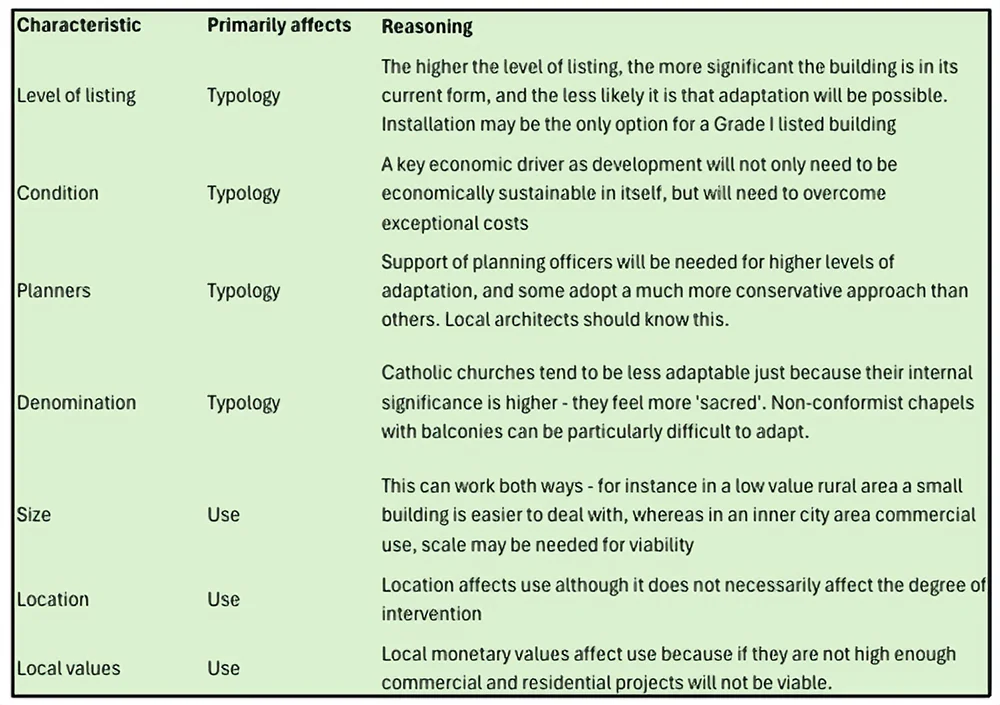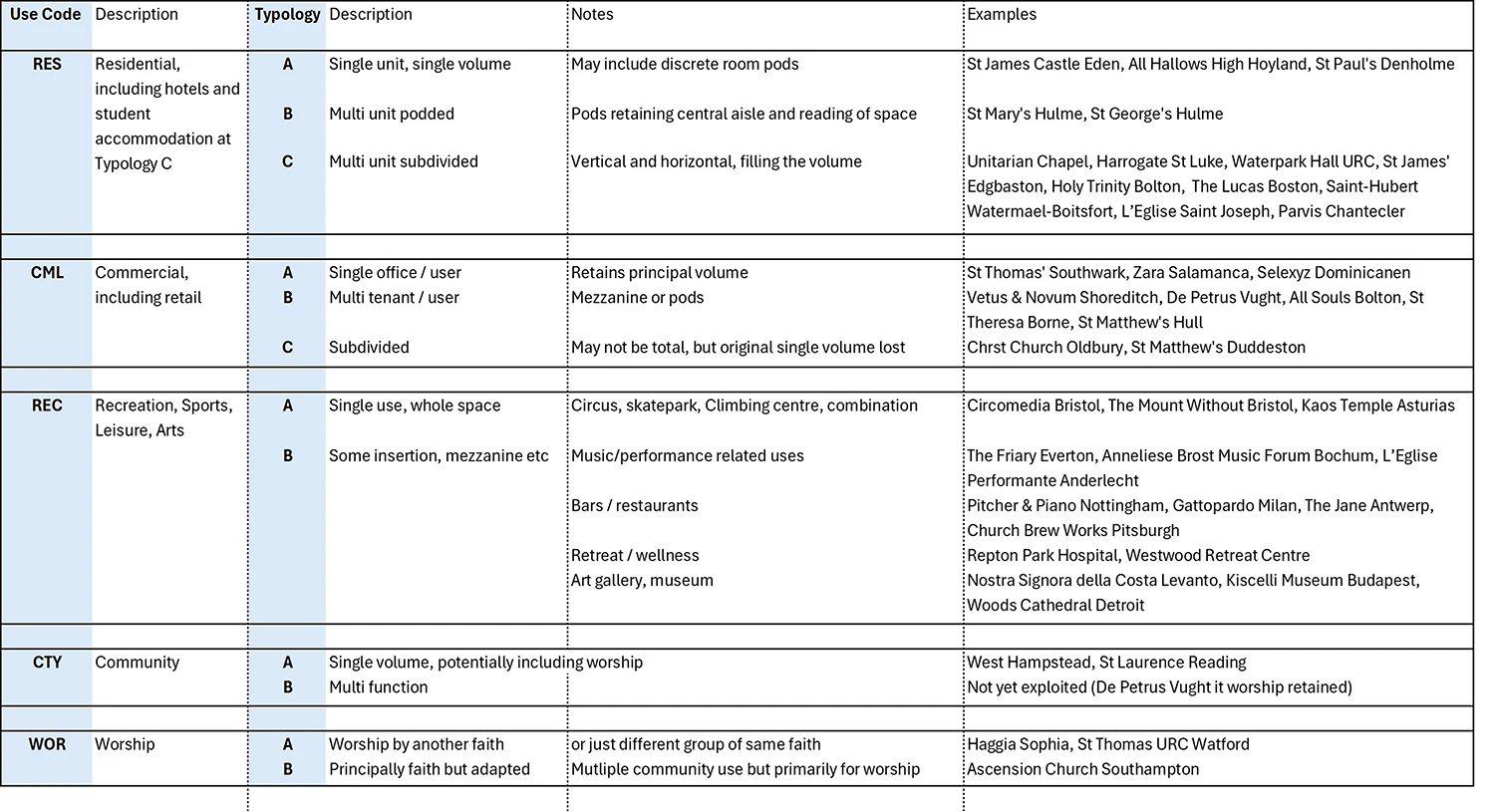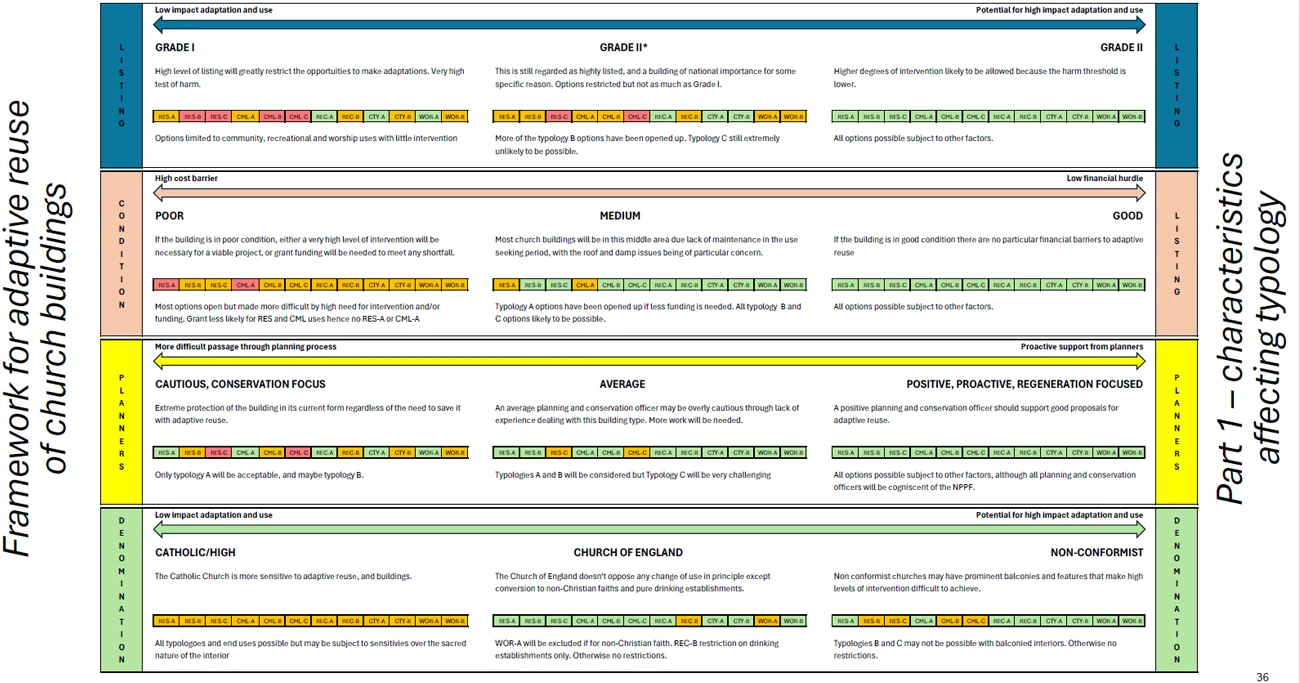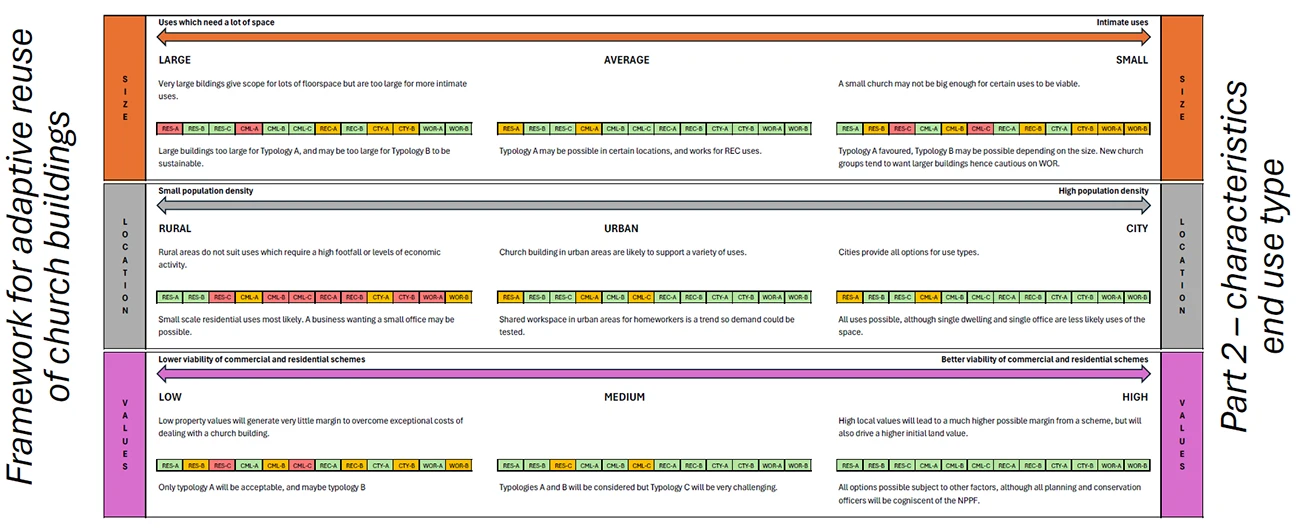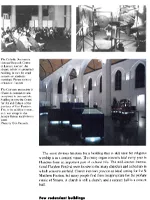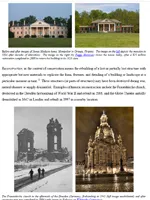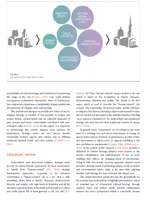Research
Adaptive Reuse of Churches
Academic research into the adaptive reuse of Churches, from Church Converts’ principal, Simon Linford
Church Converts principal Simon Linford has recently completed a Masters Degree in Architecture and Adaptive Reuse at the leading Manchester School of Architecture, specifically focusing on the adaptive reuse of church buildings. This research has not only given a very broad understanding of adaptation precedents from around the world, but has also created an innovative framework for determining the adaptive reuse strategies that are most likely to work for any given situation.
Dissertation
“The Battle to Save England’s 19th Century Anglican churches: Learning from the US and Europe”
Abstract:
This dissertation concerns what has been described as the biggest heritage crisis in England – the risk of deterioration and potential loss of church buildings. It is well known that the country has too many churches, as the number who regularly attend falls, populations move from the countryside to the towns, and as financial pressures affect churches and the Dioceses that manage them. This is an issue I am close to as a property developer specialising in heritage buildings and with a particular interest in churches. The adaptive reuse of churches is difficult because of the building form, but it is made even more difficult by the condition churches are in when they finally come to be reused, as these buildings deteriorate over the long drawn-out process of their closure and disposal. This dissertation compares the closure, disposal and adaptive reuse of churches in England with that in three other countries which seem to be better at it, to see whether there is anything that can be learned from them.
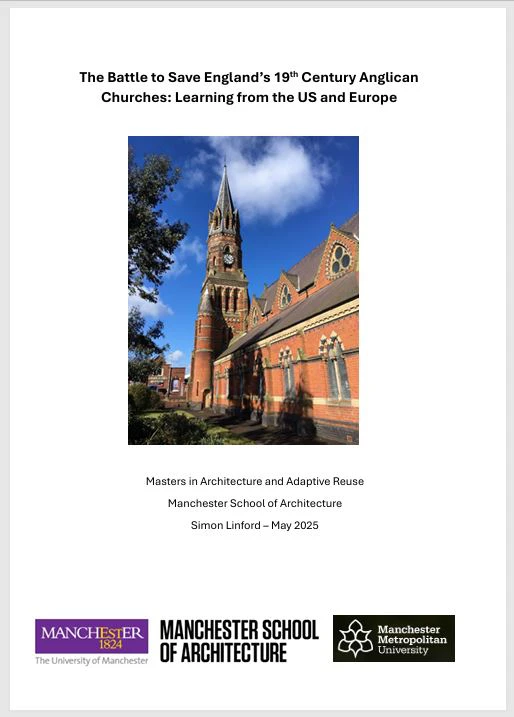
The Battle to Save England’s 19th Century Anglican churches: Learning from the US and Europe
Download the full PDF on the link below;
The Battle to Save England’s 19th Century Anglican churches: Learning from the US and Europe
(right click, save target as to download)
Framework Development
Introduction
The adaptive reuse of church buildings is one of the greatest challenges of the heritage sector. Peter Aiers, the former Chief Executive of the Churches Conservation Trust, described the problem of closing churches as “the single largest heritage issue England faces.” An excess of church buildings, coupled with decreasing church attendance and lack of financial support, is seeing churches either find new uses, or risk being demolished.
However, the closure and adaptive reuse of a church building can be a long and complex process. Closure of a sacred building is highly emotive and most Christian denominations struggle to do it. The buildings themselves have a difficult form to reuse for the types of function that may be able to save them, and local planning authorities often lack the experience and bravery to deal with proposals for churches. Time is wasted across this whole process, and during that time the buildings decay, sometimes terminally.

An Innovative New Framework for the Adaptive Reuse of Church Buildings
Download the full PDF on the link below;
(right click, save target as to download)
It is not a problem unique to Great Britain, or to any particular denomination. It is one shared by Christian counties in Europe and the rest of the world to different degrees. Some countries and cultures have a more developed approach to the reuse of church buildings. But in other countries church buildings are languishing empty and at risk.
As a developer of historic buildings with a particular interest in churches I am keen to speed up this process and save and reuse more of these beautiful buildings. Is it possible to develop a ‘framework’ that can inform the adaptive reuse strategy of a particular building, saving wasted time and money in this process?
The overall aim of this project is to develop this ‘Framework’ for the adaptive reuse of churches. In order to do that I will:
- Consider European perspectives
- Present a precedent study of church adaptations of different use types
- Consider architectural form of these precedents in more detail
- Determine the factors that will underpin a possible Framework and explain why they are important
- Test the proposed Framework against a number churches either closed or at risk with example options and designs
The Framework
The Framework which Church Converts now uses to evaluate viable uses for any closed church building starts from an analysis of the impact on possible adaptive reuse approaches of;
This then leads to a summary of the effects of those factors, four of which affect the typology or design strategy, while three primarily have an impact on use type.
The use classes and typology types are then coded, resulting in 12 basic end uses which covers at least 90% of church adaptive reuse outcomes.
Each of the seven characteristics have then been analysed to determine the likelihood of each of the 12 possible outcomes actually being viable or deliverable. This results in what is called the ‘Outcome Ribbon’. So for instance when considering the level of listing, for a Grade II listing building no outcomes are ruled out solely on account of the listing level, hence all the outcomes on the ribbon are green. By contrast, a Grade I listing has outcomes completely rules out (red), some possible but difficult (amber) and only the recreational, community and worship uses still open for consideration.
Finally, the Outcome Ribbons for all seven characteristics are combined which identifies which of the 12 end outcomes are still likely to be possible based on combined analysis of all the characteristics.
A full explanation of the development and application of this Framework is in the download.
Academic Papers
New Use of Historic Churches: Recent Developments in Ghent
Dr Marcus van der Meulen is extensively published on the subject of adaptive reuse of religious buildings particularly in the Low Countries. New Use of Historic Churches : Recent Developments in Ghent, considers a number of examples of the pioneering approach to a large number of vacant religious buildings in the Belgian City, with the Municipality and Diocese working together to find solutions under the ‘Pilot Plan Parish Churches’.
The Future of Defunct Religious Buildings: Dutch Approaches to their Adaptive Reuse
Velthuis and Spennemann consider the adaptive reuse of churches in the Netherlands in their paper ‘The future of Defunct Religious Buildings: Dutch Approaches to their Adaptive Reuse’. The Netherlands has a long history of adaptive reuse of churches.
Refurbishing the House of God: Adaptive Reuse of Religious Buildings in Flanders
Marc Dubois’ article ‘Refurbishing the House of God: Adaptive Reuse of Religious Buildings in Flanders’ is a broad consideration of the issues of adaptive reuse of such buildings.
Written by: Marc Dubois’
Refurbishing the House of God: Adaptive Reuse of Religious Buildings in Flanders
Inventivising Historic Rehabilitation & Adaptive Reuse
The incentivisation of adaptive reuse of heritage buildings by the use of historic tax credits in the United States is compared with the control of adaptive reuse in the United Kingdom by John Royall Warman ‘Incentivising Historic Rehabilitation and Adaptive Reuse in the United States and the United Kingdom’ while John Tess notes the applicability of historic tax credits in the adaptive reuse of churches in his article in the Journal of Tax Credits, ‘Historic Tax Credits and the Adaptive Reuse of Churches’.
Inventivising Historic Rehabilitation and Adaptive Reuse in the United States and the United Kingdom
Written by: John Royall Warman
Historic Tax Credits and the Adaptive Reuse of Churches
Written by: John Tess
Impact Analysis on Adaptive Reuse of Obsolete Ecclesiastical Cultural Heritage
This more complex paper by Anastasia Sedova in 2022, ‘Impact analysis on adaptive reuse of obsolete ecclesiastical cultural heritage’ considers 65 international case studies particularly to analyse how adaptive reuse of such buildings adds cultural value.
Written by: Anastasia Sedova
Impact Analysis on Adaptive Reuse of Obsolete Ecclesiastical Cultural Heritage
Adaptive Reuse of Abandoned Historic Churches: Building Type and Public Perception
You Kyong Ahn submitted her dissertation Adaptive Reuse of Abandoned Historic Churches: Building Type and Public Perception to the department of architecture at Texas A&M. It focuses on the issues related to the adaptive reuse of abandoned historic churches and how this is viewed by the public.
Written by: You Kyong Ahn
Adaptive Reuse of Abandoned Historic Churches: Building Type and Public Perception
Related Articles
From prayer to play: Belgium’s new ecclesiastic conversion trend
This article in the Brussels Times Magazine in July 2023 looks at the trend of converting ecclesiastical buildings in Belgium.
Keeping Faith: How Citizens Are Shaping the Future of Our Religious Heritage
The Netherlands and Flanders are once again the subject of study in this article in the online journal ‘the low countries’ where Lilian Grootswagers shows how there counties have been leading the way in dealing with the problem of adapting closing churches.
Caring for churches and chapels in England: the long view
If you don’t read anything else on this page, read this! Trevor Cooper, Chair of the Heritage Religious Buildings Alliance in 2024 wrote this excellent analysis of how the United Kingdon’s churches have got into the position they are in, for instance highlighting the competitive over building of Protestant churches in Victorian times which is leading to so many closures and disposals now.
Church of England Considerations
There isn’t any academic literature specifically looking at the adaptive reuse of Church of England buildings, however the following papers are useful.
The first two are the reports commissioned firstly by Government, the Taylor Review, and secondly the report commissioned by the Church of England and chaired by Rev Dr John Inge, former Bishop of Worcester, both of which raised the profile of the problem facing the Church of England.
The Taylor Review: Sustainability of English Churches and Cathedrals
Rev Dr John Inge’s Report of the Church Buildings Review Group 2015
This next report reviews the outcome of the Mission and Pastoral Measure over its first 50 years and 2000 closures and disposals. It looks at the success of disposals by type and does indicate that community uses are rarely sustainable, but residential and commercial conversions usually are, provided they are completed as envisaged.
Church Commissioners: Mission, Pastoral and Church Property Committee
The re-use of closed churches: An analysis of use types and sustainability from 1969-2019
Adrian Browning of the Church Commissioners wrote the following detailed analysis of the closure process in Building Conservation.
Closure and Reuse: The evolving procedures of the Church of England
by Adrian Browning


